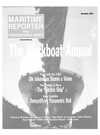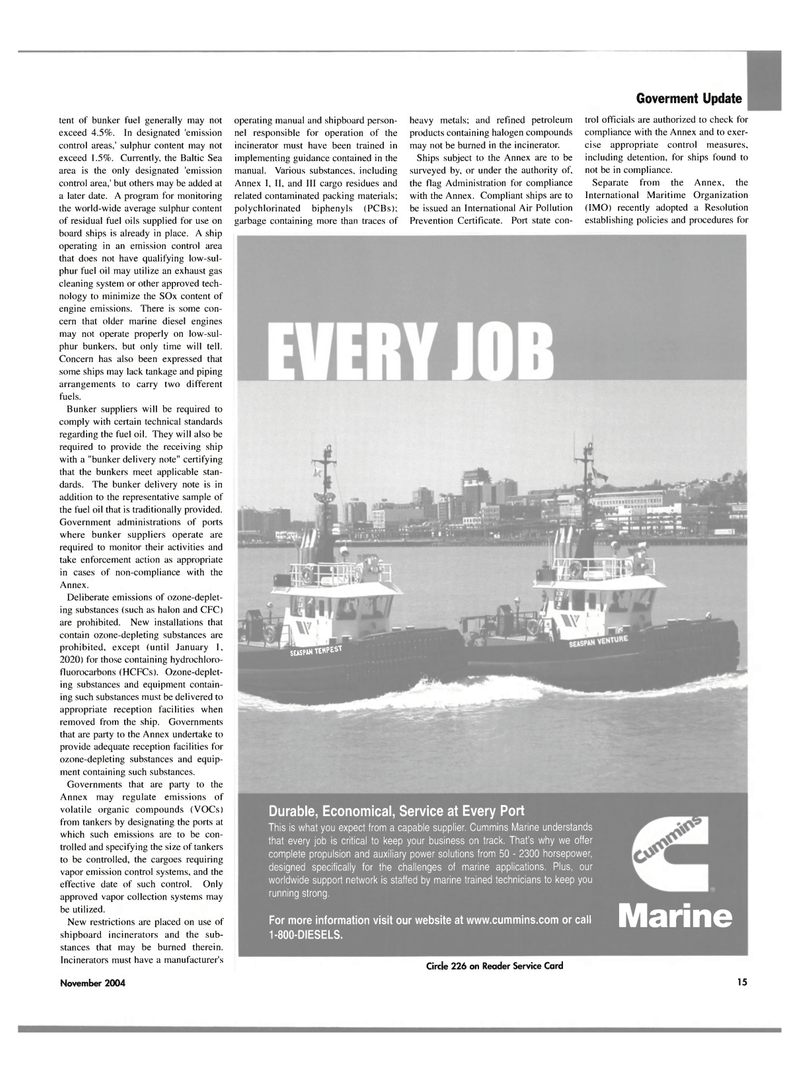
Page 15: of Maritime Reporter Magazine (November 2004)
The Workboat Annual
Read this page in Pdf, Flash or Html5 edition of November 2004 Maritime Reporter Magazine
Goverment Update tent of bunker fuel generally may not exceed 4.5%. In designated 'emission control areas,' sulphur content may not exceed 1.5%. Currently, the Baltic Sea area is the only designated 'emission control area,' but others may be added at a later date. A program for monitoring the world-wide average sulphur content of residual fuel oils supplied for use on board ships is already in place. A ship operating in an emission control area that does not have qualifying low-sul- phur fuel oil may utilize an exhaust gas cleaning system or other approved tech- nology to minimize the SOx content of engine emissions. There is some con- cern that older marine diesel engines may not operate properly on low-sul- phur bunkers, but only time will tell.
Concern has also been expressed that some ships may lack tankage and piping arrangements to carry two different fuels.
Bunker suppliers will be required to comply with certain technical standards regarding the fuel oil. They will also be required to provide the receiving ship with a "bunker delivery note" certifying that the bunkers meet applicable stan- dards. The bunker delivery note is in addition to the representative sample of the fuel oil that is traditionally provided.
Government administrations of ports where bunker suppliers operate are required to monitor their activities and take enforcement action as appropriate in cases of non-compliance with the
Annex.
Deliberate emissions of ozone-deplet- ing substances (such as halon and CFC) are prohibited. New installations that contain ozone-depleting substances are prohibited, except (until January 1, 2020) for those containing hydrochloro- fluorocarbons (HCFCs). Ozone-deplet- ing substances and equipment contain- ing such substances must be delivered to appropriate reception facilities when removed from the ship. Governments that are party to the Annex undertake to provide adequate reception facilities for ozone-depleting substances and equip- ment containing such substances.
Governments that are party to the
Annex may regulate emissions of volatile organic compounds (VOCs) from tankers by designating the ports at which such emissions are to be con- trolled and specifying the size of tankers to be controlled, the cargoes requiring vapor emission control systems, and the effective date of such control. Only approved vapor collection systems may be utilized.
New restrictions are placed on use of shipboard incinerators and the sub- stances that may be burned therein.
Incinerators must have a manufacturer's operating manual and shipboard person- nel responsible for operation of the incinerator must have been trained in implementing guidance contained in the manual. Various substances, including
Annex I, II, and III cargo residues and related contaminated packing materials; polychlorinated biphenyls (PCBs); garbage containing more than traces of heavy metals; and refined petroleum products containing halogen compounds may not be burned in the incinerator.
Ships subject to the Annex are to be surveyed by, or under the authority of, the flag Administration for compliance with the Annex. Compliant ships are to be issued an International Air Pollution
Prevention Certificate. Port state con- trol officials are authorized to check for compliance with the Annex and to exer- cise appropriate control measures, including detention, for ships found to not be in compliance.
Separate from the Annex, the
International Maritime Organization (IMO) recently adopted a Resolution establishing policies and procedures for
SUSPMH«f,EST
Durable, Economical, Service at Every Port
This is what you expect from a capable supplier. Cummins Marine understands that every job is critical to keep your business on track. That's why we offer complete propulsion and auxiliary power solutions from 50 - 2300 horsepower, designed specifically for the challenges of marine applications. Plus, our worldwide support network is staffed by marine trained technicians to keep you running strong.
For more information visit our website at www.cummins.com or call 1-800-DIESELS.
Circle 226 on Reader Service Card
Marine
November 2004 15

 14
14

 16
16
